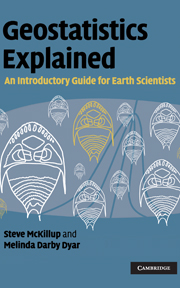Borradaile, G. J. (2003) Statistics of Earth Science Data. New York: Springer.
Chalmers, A. F. (1999) What Is This Thing Called Science? 3rd edition. Indianapolis: Hackett Publishing Co.
Davis, J. C. (2002) Statistics and Data Analysis in Geology. New York: Wiley.
Fisher, R. A. (1954) Statistical Methods for Research Workers. Edinburgh: Oliver and Boyd.
Gamst, G., Meyers, L. S. D. and Guarino, Q. J. (2008) Analysis of Variance Designs: A Conceptual and Computational Approach with SPSS and SAS. Cambridge: Cambridge University Press.
Hurlbert, S. J. (1984) Pseudoreplication and the design of ecological field experiments. Ecological Monographs 54: 187–211.
Koch, G. S. and Link, R. F. (2002) Statistical Analysis of Geological Data. New York: Dover Publications.
Krumbein, W. C. (1939) Preferred orientation of pebbles in sedimentary deposits. Journal of Geology 47: 673–706.
Kuhn, T. S. (1970) The Structure of Scientific Revolutions. 2nd edition. Chicago: University of Chicago Press.
LaFollette, M. C. (1992) Stealing into Print. Fraud, Plagiarism and Misconduct in Scientific Publishing. Berkeley, CA: University of California Press.
Lakatos, I. (1978) The Methodology of Scientific Research Programmes. New York: Cambridge University Press.
Murray, R. C. and Tedrow, J. C. F. (1992) Forensic Geology. Englewood Cliffs, NJ: Prentice Hall.
Popper, K. R. (1968) The Logic of Scientific Discovery. London: Hutchinson.
Siegel, S. and Castallan, J. J. (1988) Statistics for the Behavioral Sciences. 2nd edition. New York: McGraw-Hill.
Singer, P. (1992) Practical Ethics. Cambridge: Cambridge University Press.
Sokal, R. R. and Rohlf, F. J. (1995) Biometry. 3rd edition. New York: W. H. Freeman.
Sprent, P. (1993) Applied Nonparametric Statistical Methods. 2nd edition. London: Chapman & Hall.
Stanley, C. R. (2006) Numerical transformation of geochemical data: 1. Maximizing geochemical contrast to facilitate information extraction and improve data presentation. Geochemistry: Exploration, Environment, Analysis 6: 69–78.
Strom, R. G., Schaber, G. G. and Dawson, D. D. (1994) The global resurfacing of Venus. Journal of Geophysical Research 99: 10899–10926.
,Student (1908) The probable error of a mean. Biometrica 6: 1–25.
Tukey, J. W. (1977) Exploratory Data Analysis. Reading: Addison-Wesley.
Ufnar, D. F., Groecke, D. R. and Beddows, P. A. (2008) Assessing pedogenic calcite stable isotope values; can positive linear covariant trends be used to quantify palaeo-evaporation rates?Chemical Geology 256: 46–51.
Vermeij, G. J. (1978) Biogeography and Adaptation: Patterns of Marine Life. Cambridge, MA: Harvard University Press.
Woods, S. C., Mackwell, S. and Dyar, D. (2000) Hydrogen in diopside: Diffusion profiles. American Mineralogist 85: 480–487.
Zar, J. H. (1996) Biostatistical Analysis. 3rd edition. Upper Saddle River, NJ: Prentice Hall.
Zelen, M. and Severo, N. C. (1964) Probability functions. In Handbook of Mathematical Functions, Abramowitz, M. and Stegun, I. (eds.). Washington, DC: National Bureau of Standards, pp. 925–995



